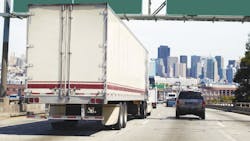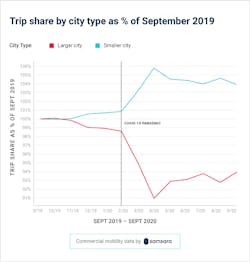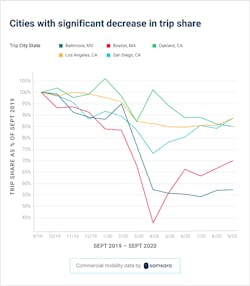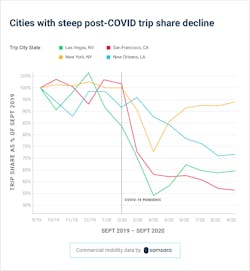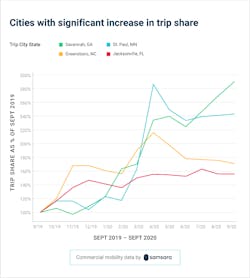COVID pushed people out of big cities, Samsara data reveals
Telematics provider Samsara took a deep dive into consumer-based commercial transportation data before and during the COVID-19 pandemic (September 2019 through September 2020) and discovered the tumultuous events from 2020 may be speeding up a mass exodus from urban areas in favor of rural or suburban settings.
Samsara examined trip share data—the amount of trips measured in one city relative to the total number of trips in all cities analyzed—in three specific industries: food and beverage; wholesale and retail; and transportation and warehousing. The data was generated from more than 15,000 customers who completed 48 million trips to and from the 200 largest U.S. cities.
The company found that in April 2020 activity declined by 9% in the top 25 cities, defined as large cities in the study, and rose by 6% in the lower 175, classified as small cities, versus September 2020.
A Realtor.com report from May 2020 showed that searches for homes in suburban zip codes rose 13%, almost twice as much as urban searches.
“Although urban cores have boomed over the past decade, downtown density has become a liability during the pandemic, putting city-dwellers at increased health risk by virtue of their close proximity with others,” surmised economist Chris Salviati in Apartment List’s Q2 2020 migration report. He said the lower cost of living and lighter population density of smaller cities made them more desirable during the pandemic, while advantages of living in a big city, such as easy access to restaurants and cultural institutions, were eliminated by the shutdowns.
The Samsara data revealed some large cities were already experiencing a decline in trip shares, such as Boston, Baltimore and San Diego. Those trip shares went from a stumble to full-on swan dive once the gravity of the pandemic was fully realized in March 2020. While Boston took the biggest temporary hit, losing more than half of its trip shares compared in April 2020 from September 2019, Baltimore has the longest lasting damage, down 43% in trip shares as of September 2020 y/y. The Charm City’s population is under 600,000 for the first time in over a century, according to U.S. Census data.
“Interestingly, three of these cities with significant declines in trip share—Los Angeles, Oakland, and San Diego—are in the state of California,” writes Ali Akhtar, author of the Samsara report. “This could be due to the state’s strict COVID-19 restrictions, large decrease in tourism (and the resulting high unemployment rate), or other factors.”
As of September 2020, Las Vegas , New Orleans and San Francisco, typical tourist hot spots in the spring, saw severe drops in trip share as the coronavirus pandemic heightened, and have yet to rebound, unlike New York City, which declined 28% as of April 2020 and climbed back to near normal, just 5% lower for September year over year. The others are still struggling to recover, with New Orleans down almost 30%, Las Vegas at 35%, and San Francisco about 45% from September 2019.
Meanwhile, smaller cities, particularly in the Southeast, are on the upswing. Savannah, Ga., has nearly tripled from September 2019 to September 2020, up 190%. The city’s trip share volume is likely booming due to an increase in port activity. Greensboro, N.C., and Jacksonville, Fl., experienced increases of 70% and 55%, respectively. Despite being the epicenter of the summer’s civil unrest to protest police brutality, the Twin Cities of Minneapolis and St. Paul rose in trip share, with 195% for the former and a 140% increase for the latter. Samsara noted that these cities eased stay-at-home orders by early May.
“It’s possible that faster reopening could have led to increased trips, compared to other regions of the country that had a longer lockdown period,” theorized Akhtar.
About the Author
FleetOwner Staff
Our Editorial Team
Kevin Jones, Editorial Director, Commercial Vehicle Group
Josh Fisher, Editor-in-Chief
Jade Brasher, Senior Editor
Jeremy Wolfe, Editor
Jenna Hume, Digital Editor
Eric Van Egeren, Art Director
